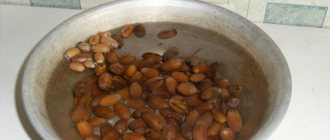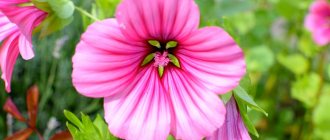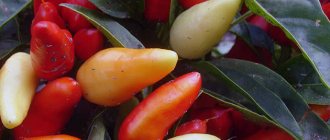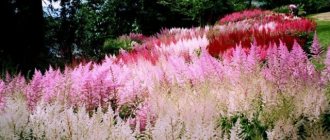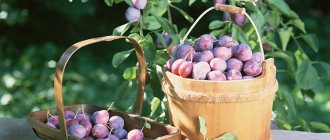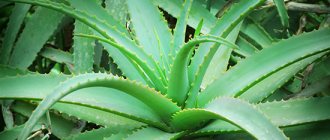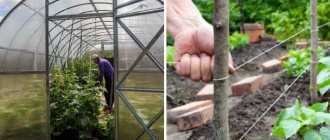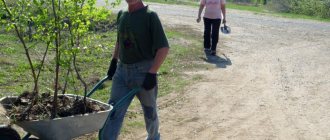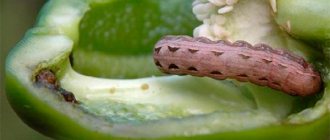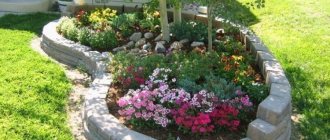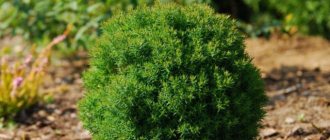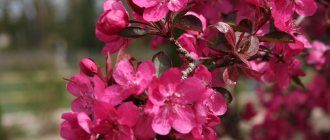The origin of the name of the plant, unsightly in appearance, but aromatic and rich in beneficial properties, is shrouded in legends. According to one version, the name is formed by two Greek words, translated meaning “honey bee”; Melissa is the name of the nymph who treated Zeus himself with milk and honey; according to another version, the beauty, transformed by the will of the gods of Olympus into a bee, was called Melissa.
Melissa is a good honey plant, which is why it has received popular nicknames such as honey plant, queen plant, bee plant, and swarmer plant. You recognize the plant by its strong lemon aroma, which gives it another name: lemon balm. Other names: censer, lemon balm, mint, bee mint.
When does lemon balm bloom?
When lemon balm blooms photo of flowering
Melissa begins to bloom in the second year of growth. The flowering period of lemon balm is July-August. Before flowering, the plant smells of lemon; after flowering, the aroma becomes sharp.
During the flowering period, bunches of small white, pinkish or purple flowers appear in the axils of the leaves. The upper ovary of the pistil is four-parted, on a long style, each flower has four pistils.
After flowering ends, the fruits and nuts begin to ripen.
Melissa is cultivated in gardens, vegetable gardens and personal plots, and is also grown on plantations on an industrial scale.
Melissa varieties with name, photo and description
Let's consider the best varieties of lemon balm for growing in a personal plot.
Melissa Lemon tea photo
Lemon tea – flowering occurs 80 days after sowing, the flowers are white. The yield is 2.9 kg per 1 m².
Melissa Mojito photo
Mojito - white flowers appear 5 months after sowing. From 1 m² you can harvest more than 3 kg of crop.
Melissa Freshness photo
Freshness - bushes about 80 cm high with blue flowers. In two cuttings you can collect 4.3 kg of young shoots and leaves. Suitable for growing on farms and in private plots.
Lada is a very productive variety (dry weight yield 34 c/ha), grown on an industrial scale.
Melissa Zhemchuzhina photo
Pearl - the variety is suitable for growing in all winter hardiness zones. Productivity reaches 5.6 kg per 1 m².
Melissa Lemon Balm photo
Lemon balm - blooms 2.5 months after germination. The stems are semi-lodging, the flowers are purple. Productivity – 3 kg.
Dozya is a plant 0.9 m high with dark green leaves and snow-white flowers. From the second year of growth, the yield of green mass is 3.4 kg.
Quadrille - each bush produces no more than 15 shoots, the yield is up to 1.5 kg per 1 m². Flowers of a light lilac hue bloom after 80 days.
Melissa Lemon scent photo
Lemon aroma is an excellent variety for gardening. The height of the bushes is 60 cm, which is convenient for growing in a container. The plant produces a yield of 1.2 kg per 1 m².
Tsaritsynskaya Semko - the stem is erect, branched, the shoots are densely covered with small leaves. The yield is more than 2 kg.
Isidora is a plant up to 0.8 m high. The first harvest can be harvested 2 months after emergence. Productivity – up to 3.5 kg per 1 m².
Under natural conditions, lemon balm grows in forests located in central Russia. This medicinal plant, widely used in medicine in the treatment of many diseases, has several names among the people:
From an agronomic point of view, lemon balm is a grass belonging to the perennial plant segment. The color of the leaf part of the plants depends on the specific varieties - it can be either green or have a silvery tint.
Note. Melissa planting and care in open ground have some specific features related to the requirements for maintaining the special condition of the soil, but another notable characteristic is that lemon balm is a honey plant, which explains the origin of many popular names.
Melissa is present in a huge number of medications. However, in addition to medicinal use, the leaves and shoots of this herb, which have a lemon aroma, are used in the manufacture of certain types of culinary products:
- seasoning for dishes;
- additive to canned vegetables;
- improving the taste of liqueurs;
- tea leaves
Place to grow lemon balm
How to plant lemon balm with seeds in open ground photo
Illumination
The most suitable place for growing lemon balm will be an open area, well lit by sunlight. The seeds will germinate successfully, the plant will develop better and delight with a richer aroma. The culture is resistant to cold weather, but it is preferable to grow lemon balm on the south side with protection from strong winds.
Priming
The soil requires fertile, well-drained, neutral or slightly acidic reaction. Preferred are loamy soils with high water and air permeability, which allows you to grow full-fledged plants. It is possible to grow in sandy loam soil with drainage that protects the root system from rotting. To do this, broken brick or crushed stone is brought under the digging.
Heavy loamy soil should be diluted by adding river sand. Feed depleted soil with rotted manure or humus; you can also use complex mineral fertilizers. Carry out the first digging with the removal of weeds and adding the necessary components in the fall, loosen again in the spring and remove the weeds.
How to plant lemon balm with seeds in open ground
Lemon balm seeds photo
When to plant lemon balm seeds in the ground
This is a universal plant; sowing can be carried out throughout the spring from March to May, in the summer in June-August, and even in the fall before winter in mid-late October (before frost, so that the seeds do not germinate).
How to plant
The seeds are very small: 60 g of weight contains more than 1000 seeds. Seed germination persists for 2-3 years.
- Sowing seeds in open ground is carried out in the spring, when the soil is well warmed up and constant warmth sets in, around the end of May.
- The embedment depth is 1-1.5 cm.
- Make furrows, moisten the soil, sow the seeds sparsely and cover with soil.
- Shoots will appear after 3-4 weeks.
- Thin out the seedlings, leaving about 20 cm between individual plants.
Meet the green queen of the front garden
Melissa is a herbaceous perennial that belongs to the Lamiaceae family. In the natural environment, it is found throughout almost the entire territory of Eurasia, as well as in the northern part of the American continent. It grows:
- among the bushes;
- along river banks;
- on forest edges;
- on rocky slopes;
- along steppe roads.
Its homeland is the Mediterranean, where it is considered an unsightly weed. Despite this, in ancient Rome, experienced gardeners everywhere grew lemon balm in their garden plots. This is what contributed to its spread throughout the continent. The name of the perennial is associated with many legends. According to the most popular version, Melissa is the name of a girl who was turned into an insect by the evil Greek gods. And translated into Russian, the name means “honey bee”. Whichever version is correct, this does not prevent fans of green spaces from growing lemon balm in their summer cottage.
Looking at the plant from the outside, you can note its excellent features:
- branched root system;
- many lush shoots with a rectangular cross-section, directed in different directions;
- plant height reaches over 1 meter;
- heady citrus scent.
If you look closely at the leaf blades, you will see unusual fleshy specimens. They are strewn with many thin veins located against the background of a relief surface. The edges of the ovoid opposite leaves are decorated with serrations. The tips are slightly elongated, which gives them unprecedented beauty. All of them are painted bright green and covered with barely noticeable fibers.
In the second year after planting, in mid-summer, umbrella-shaped buds appear at the tips of the slender stems. Located in the leaf axils, snow-white or blue inflorescences look original against the backdrop of a lush bush. Thanks to the elongated lower petals, the buds have an asymmetrical shape, in the center of which there is a pistil surrounded by 4 stamens. Approximately 30 days after pollination, fruits appear in the form of egg-shaped nuts. They are covered with a dense, shiny black crust. Inside the fruit there are 4 seeds that remain viable for about 3 years.
When purchasing seed, you should take into account the fact that 60 g contains more than 1,500 seeds.
How to grow lemon balm from seeds for seedlings at home
Melissa growing from seeds at home photo of seedlings
You can get stronger and more resilient plants that will produce a rich harvest of fragrant leaves by growing seedlings.
When to plant
Sowing is carried out between the end of March and the beginning of April. Then by May you will have complete planting material. For sowing you will need wide, low containers (use containers, wooden boxes or special boxes for growing seedlings). The soil needs to be nutritious and loose.
How to plant
Fill the container with earth, level it, sow the seeds in the furrows, deepening them by about 0.5-1 cm. Then moisten by spraying with a spray bottle. Cover the top with film or glass to create greenhouse conditions, lift the shelter daily for ventilation, and remove it completely when seedlings appear.
- Germination of seeds and further care of seedlings should occur at an air temperature within 23-25 ° C and bright, diffused lighting; moderate soil moisture will also be required.
- When the shoots appear, wait until they grow a little, then thin out, leaving the best quality shoots, keeping a gap of 5 cm between individual plants.
- At the stage of appearance of a couple of true leaves, plant them in separate containers - plastic cups are perfect. If the containers are spacious, the plants can be grown without intermediate replanting.
- Transplant lemon balm seedlings into open ground around mid-May. Handle the seedlings along with the earthen ball; make a planting hole of the appropriate size for this purpose. The root collar should be flush with the soil surface.
Growing at home on a windowsill
Melissa can be cultivated at home as a houseplant. If you take a small pot, it will not grow much. With the help of pruning and constant care, you will get a lush compact bush on the windowsill.
For growing indoors, the rules are the same as for open ground. When to plant to start a houseplant from seed does not matter. After the third leaf appears, the seedlings are planted in separate pots. The containers must correspond to the following dimensions: volume 1.5–2 liters, height – up to 15 cm. Drainage made of pebbles or expanded clay is placed at the bottom of the pot. Pour the prepared soil and plant 2-3 sprouts in each pot. Moisten the soil with a spray bottle. Place it on the windowsill.
To maintain the proper quality of leaves, abundant watering and regular spraying of the plant are necessary.
Every 3-4 years the plant is replanted, renewing the soil in the pot. In winter, without additional lighting, the bush will grow, only the leaves will lighten a little.
Vegetative propagation of lemon balm
Vegetative propagation of lemon balm involves dividing the bush and rooting cuttings.
Reproduction of lemon balm by dividing the bush
How to divide a lemon balm bush photo
You can divide bushes that are 3-4 years old - by this time they will have grown well. The most favorable dates for division are the end of May or the end of August. Carefully dig up the bush and divide it into parts of approximately equal size, each of which should contain formed roots and 4-5 shoots. Plant the cuttings immediately in open ground. To ensure they take root well, provide shade and moderate watering.
Propagation by cuttings
How to take lemon balm cuttings Rooting cuttings in water photo
For rooting in the spring, cut apical cuttings from young shoots. After cutting, place in water, you can add a growth stimulator. The roots will appear in about 2 weeks. Grow in containers with nutritious loose soil, then transplant into open ground.
Lemon balm cuttings rooted in the ground photo
Melissa is easily propagated by cuttings, and if you don’t want to disturb old bushes, just cut the cuttings and root them to quickly get excellent planting material.
Sowing lemon balm by seed method
This medicinal plant can be sown throughout the spring and summer seasons, until the very end of October.
Breeding lemon balm using the seed method is considered the most labor-intensive among other existing breeding technologies. However, this method of planting lemon balm at your dacha from seeds is recognized as the most effective. This statement is due to the fact that bush plantings of lemon balm obtained as a result of seed germination are more powerful and also more viable. An important advantage of plants grown from seeds is their resistance to adverse weather conditions. Planting seed material can be sown both in open ground conditions and in a container for germinating seedlings, which is subsequently also planted on an open ridge.
Important! You can carry out the necessary disinfection of garden soil before growing lemon balm on it by heating the oven and placing planting material in it or by spilling freshly boiled water on the soil.
Note. Ready-made soil mixture purchased in a store does not require heat treatment.
The process of planting seeds
The seeds are very small in size and retain the ability to germinate for 2 years after they have been sown.
Caring for lemon balm in open ground
There is no difficulty in planting and caring for lemon balm - it is unpretentious, and care does not require any special specifics.
Weeding and loosening the soil
In the first year after planting, more careful attention will be required. Young plants have not yet matured and can easily be destroyed by weeds. It is better to pull out weeds by hand. Loosen the soil regularly to ensure oxygen access to the root system. Successful rooting will have a beneficial effect on the further development of lemon balm and productivity.
Watering
During the initial growth stage, water sparingly. Adult plants are watered only during severe drought, and watering is supplemented by loosening the soil. A layer of mulch will help maintain soil moisture longer and prevent weeds from appearing. Use humus or compost as mulch, which will additionally serve as fertilizer.
How to feed
It is enough to feed lemon grass once a season - at the beginning of the growing season. Use complex mineral fertilizers (the proportions per 10 liters of water are 50 g of superphosphate, 20 g of ammonium nitrate, 15 g of potassium chloride, consumption per 1 m²). To ensure that the plant overwinters successfully, feed it with potassium-phosphorus fertilizers at the end of summer.
Trimming
Don't be afraid to prune your lemon balm. After pruning, it quickly recovers, produces a large number of new branches, and the bushes become dense. This will allow you to reap a good harvest, and neat, pretty bushes will decorate your site. Even when growing seedlings, pinch the shoots at a height of 10-15 cm. In the future, radically trim the bushes two or three times a season: at a distance of 10 cm above the soil surface.
Harvest and storage
How to prepare lemon balm herb photo
Regarding the question of when to cut lemon balm for drying, everyone decides for themselves. Melissa is capable of producing 3-4 crops per season. In June, young leaves have a delicate taste and aroma - at this time it is already possible to harvest. With the beginning of flowering, the concentration of essential oils is maximum, due to which the aroma intensifies, but the leaves become tougher.
Leaves and tips of lemon balm shoots, collected during flowering, are medicinal raw materials. It is officially recognized in more than a dozen countries. Gourmets also prefer to harvest lemon balm at this time. Melissa's ability to quickly recover allows you to harvest before and during flowering.
For collection, it is better to choose a cloudy day, when the evaporation of beneficial essential oils is minimal. Dry in the shade at an air temperature of no more than 35 °C, ventilation is necessary. To dry, spread the raw materials on paper or fabric; you can use cold dryers. After drying, store in glass jars with a well-closing lid, porcelain containers, or put in a plastic bag. The shelf life is two years.
Beneficial properties of lemon balm
Melissa can be called a dream come true for the most sophisticated gourmets: it combines a citrus aroma and subtle honey notes. It gives dishes a tonic, refreshing taste. In fresh or dried form, lemon balm is added to hot dishes (be it meat, fish or soup), to mushrooms, seasoned salads, and also used for pickling cucumbers and tomatoes. From this herb you can make an incredibly aromatic and healthy tea, a refreshing summer drink or liqueur.
Melissa can be called a universal remedy. Since ancient times, the plant has been used to treat diseases of the stomach, liver, and gall bladder. This is an excellent sedative for nervous disorders, hysteria, insomnia, lemon balm tea helps relieve headaches and dizziness. Currently, lemon balm is used in the complex treatment of diseases of the gastrointestinal tract, nervous and cardiovascular systems, and diseases of the upper respiratory tract. Melissa also helps the female body with various diseases of the genital tract, hormonal imbalances, and menstrual irregularities.
Plant varieties
There are many varieties of lemon balm in nature. Each of them differs in the size of the bush, the shape and color of the leaves, the duration of flowering and aroma. Common varieties of lemon balm:
- lemon;
- pearl;
- Tsaritsynskaya,
- lime;
- freshness;
- erect.
There are also varieties of the spicy plant in which the color is very different from ordinary lemon balm - this variety is called “pure gold” due to the fact that the leaves have a light yellow tint. And when the sun's rays hit them, the thin pearlescent fibers shimmer in the sun.
A popular variety of lemon balm that can be found in fields and grown even at home in an ordinary flower pot is Variegated lemon balm. It has a bright aroma and has dark green leaves with golden veins.
You need to know that some varieties are decorative, and some can be used for cooking, as a spice and for medicinal purposes.
If we compare Russia with other countries, then in Europe it is common to cultivate lemon balm en masse in fields, gardens and even on balconies. Melissa leaves are added to salads, soups and drinks. It has a light lemon aroma. Imagine how just a few lemon balm leaves can enrich the taste of spinach soup!
If you fall into the category of “beginner gardeners” and want to grow lemon balm from seeds, then you need to familiarize yourself with the process and learn how to grow lemon balm.
